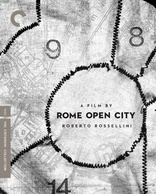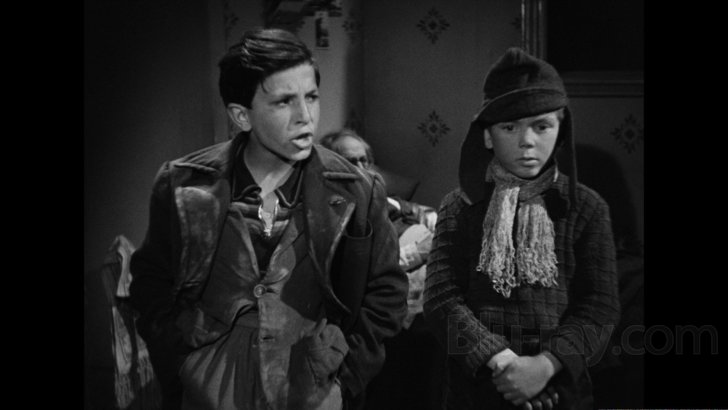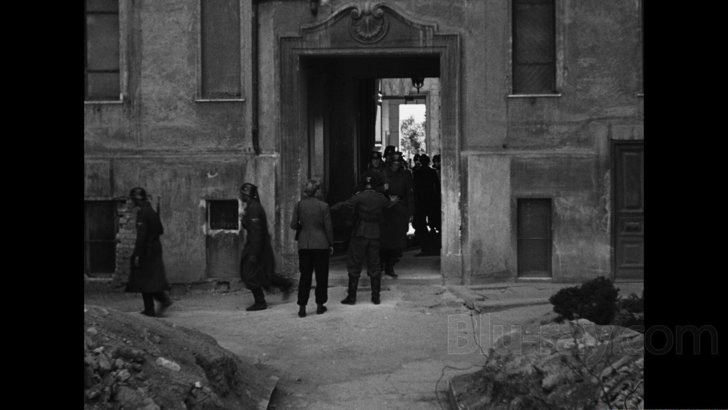Rome, Open City Blu-ray Movie
HomeRome, Open City Blu-ray Movie 
Roma città apertaCriterion | 1945 | 103 min | Not rated | No Release Date

Price
Movie rating
7.8 | / 10 |
Blu-ray rating
| Users | 0.0 | |
| Reviewer | 4.5 | |
| Overall | 4.5 |
Overview
Rome, Open City (1945)
A harrowing drama about the Nazi occupation of Rome and the brave few who struggled against it.
Starring: Anna Magnani, Aldo Fabrizi, Marcello Pagliero, Vito Annichiarico, Nando BrunoDirector: Roberto Rossellini (I)
| Foreign | Uncertain |
| Drama | Uncertain |
| War | Uncertain |
Specifications
Video
Video codec: MPEG-4 AVC
Video resolution: 1080p
Aspect ratio: 1.37:1
Original aspect ratio: 1.37:1
Audio
Italian: LPCM Mono
Subtitles
English
Discs
50GB Blu-ray Disc
Single disc (1 BD)
Playback
Region A (locked)
Review
Rating summary
| Movie | 5.0 | |
| Video | 4.5 | |
| Audio | 4.5 | |
| Extras | 4.5 | |
| Overall | 4.5 |
Rome, Open City Blu-ray Movie Review
Reviewed by Dr. Svet Atanasov June 6, 2017Winner of the Grand Prize at the Cannes Film Festival, Roberto Rossellini's "Roma, Cita Aperta" a.k.a. "Rome, Open City" (1945), arrives on Blu-ray courtesy of Criterion. The supplemental features on the disc include an archival video introduction by the Italian director; Marie Genin and Serge July's documentary film Once Upon a Time... "Rome, Open City" (2006); archival video essay by writer Mark Shiel; archival video interview with renowned Italian film historian and critic Adriano Apra; and more. Also included with the release is an illustrated booklet featuring essays by critics James Quandt, Irene Bignardi, Colin McCabe, and Jonathan Rosenbaum. In Italian, with optional English subtitles for the main feature. Region-A "locked".

Under siege
Note: Rome, Open City is part of Criterion's upcoming Roberto Rossellini's War Trilogy three-disc Blu-ray box set.
Rome, Opem City was shot on the streets of the Italian capital literally a few months after the allied liberation. It has a distinctively raw appearance and an atmosphere that effectively separate it from other similarly themed films from the same era.
The film tells a story but does not have traditional central characters. Initially, the camera follows closely Giorgio (Marcello Pagliero, Roma città libera), an idealistic resistance leader, who has become an important target for the ambitious Gestapo officer Bergmann (Henry Feist). Giorgio decides to hide in the apartment of close friend Francesco, and while waiting for him, he encounters his fiancée, Pina (Anna Magnani, Mamma Roma), a kind widow who lives life one day at a time. Pina quickly sends her son Marcello (Vito Annichiarico) to bring back Don Pietro (Aldo Fabrizi), a catholic priest who has been assisting the resistance movement and knows how to help Giorgio transfer money to other fighters across the country.
On the day of Francesco and Pina’s wedding, the Nazis surround the neighborhood and begin searching for Giorgio. He manages to escape and contacts a beautiful cabaret actress (Maria Michi, Last Tango in Paris) with whom he once had an affair. Soon after, someone points Gestapo in the right direction and Giorgio, Don Pietro and other resistance sympathizers are promptly arrested.
The film is broken into multiple episodes that focus on different events. Virtually all of them are staged, but they don’t follow the conventional rules of continuity. As a result, one gets the impression that many of them were captured by the camera as they occurred in real time and are presented unedited.
The relationships between the main characters are clearly identified, but their evolution is secondary. A character can make a dramatic appearance in one episode and then be completely ignored for the rest of the film. Another character can exit the film at a time when it would appear that it will surely have an important role during the eventual resolution.
The city appears as the one and only character whose past and future will be remembered. It has been brought to its knees and forced to endure human madness, but occasionally it shows signs of life. There are a few panoramic sequences that look quite beautiful, but the rest of the footage is notably raw and depressing.
Magnani and Fabrizi are astonishing, but the entire cast deserves a lot of praise for the film’s tremendous power. Watch the sequence with the kids whistling the partisan tune before the execution and you will understand why.
Roberto Rossellini shot Rome, Open City with cinematographer Ubaldo Arata. It is the first film in his acclaimed War Trilogy. The other two films are Paisan a.k.a. Paisan (1946) and Germania anno zero a.k.a. Germany Year Zero (1948).
Rome, Open City Blu-ray Movie, Video Quality 

Presented in its original aspect ratio of 1.37:1, encoded with MPEG-4 AVC and granted a 1080p transfer, Roberto Rossellini's Rome, Open City arrives on Blu-ray courtesy of Criterion.
The release is sourced from the 4K restoration of Rome, Open City that was carried out by Cineteca di Bologna and CSC - Cineteca Nazionale at L'Immagine Ritrovata laboratory in 2013. The British Film Institute accessed the same restoration in 2015 when it prepared its Region-B Blu-ray release.
There are some quite obvious discrepancies between Criterion's technical presentation of the film and the previous presentation from the BFI. First, I wish to mention that some of the same light filtering corrections that are noticeable on the Region-B release are also present here, which leads me to believe that during the restoration process some adjustments were made to rebalance the image as best as possible. My guess is that various age-related imperfections were addressed, and in some cases where there were very obvious traces of fading additional work was done. The bulk of these enhancements are very good. However, on the BFI release there are some pretty obvious gamma fluctuations, so either the disc wasn't encoded with proper gamma levels or there are actually additional corrections on the Criterion release. On the upcoming release the entire film looks slightly darker and has significantly better balanced visuals. For example, if you compare screencapture #1 and screencapture #2 and especially screencapture #18 and screencapture #19 from our review of the Region-B release, you will immediately notice that the improved gamma significantly minimizes some of the more obvious effects of the filtering adjustments mentioned above and in the process even quite dramatically helps depth. Many of these specific discrepancies can make quite a big difference on large screens. This being said, I think that in select segments shadow definition still could have been more convincing without the additional digital work that was done during the restoration, but select balance improvements almost certainly would not have been possible. There are no traces of problematic sharpening adjustments. Distracting debris, scratches, dents, damage marks, stains, and other age-related imperfections have been removed as best as possible. My score is 4.25/5.00. (Note: This is a Region-A "locked" Blu-ray release. Therefore, you must have a native Region-A or Region-Free player in order to access its content).
Rome, Open City Blu-ray Movie, Audio Quality 

There is only one standard audio track on this Blu-ray release: Italian LPCM 1.0 (with small portions of German and a few lines in English). Optional English subtitles have been provided for the main feature.
Clarity and depth are good, though there are segments where it immediately becomes clear that time must have irreversibly impacted the native qualities of the surviving elements because some small fluctuations remain (these can range from sporadic 'thinning' of the audio to weaker than usual high-frequencies). On the other hand, it is very possible that Criterion have done some additional work to further attenuate hiss and other noticeable age-related imperfections.
Rome, Open City Blu-ray Movie, Special Features and Extras 

- Introduction - presented here is an archival introduction by Roberto Rossellini which was filmed for Roberto Rossellini Presents, a 1963 French television series introducing his films. It was directed by Jean-Marie Coldefy. In French, with optional English subtitles. (4 min, 1080p).
- Once Upon a Time... "Rome, Open City" - this documentary film examines the historic significance of Rome, Open City and Roberto Rossellini's shooting and stylistic preferences. Included in it are clips from archival interviews with directors Vittorio Taviani (The Night of the Shooting Stars), Federico Fellini, and Carlo Lizzani (Wake Up and Kill), actress Anna Magnani, Luca Magnani (son of Anna Magnani), critic Adriano Apra, and Isabella Rossellini, amongst others. The documentary was produced by Marie Genin and Serge July in 2006. In Italian, French, and English, with optional English subtitles where necessary. (53 min, 1080i).
1. Nazi-occupied Rome
2. Demystifying the movie machine/Neorealism
3. Fascist-trained directors
4. The right timing/Anna Magnani
5. Anna, Romano, and the kids
6. Lighting, courage, success
7. Ingrid, genius, and morality
- Adriano Apra - presented here is an archival video interview with renowned Italian film historian, teacher, and critic Adriano Apra in which he discusses Roberto Rossellini's Rome, Open City and the socio-political environment in which the film was produced. The interview was conducted exclusively for Criterion in 2009. In Italian, with optional English subtitles. (13 min, 1080i).
- Rossellini and the City - presented here is an archival video essay by writer Mark Shiel (Italian Neorealism: Rebuilding the Cinematic City) in which he discusses the topography in Roberto Rossellini's films Rome, Open City, Paisan, and Germany Year Zero and how it enhanced and ultimately defines their neorealistic qualities. The essay was created exclusively for Criterion in 2010. In English, not subtitled. (26 min, 1080i).
- Father Virgilio Fantuzzi - in this archival video interview, Father Virgilio Fantuzzi, a film critic and friend of Roberto Rossellini, discusses the unique role religion has in Rome, Open City, and why contrary to his insistence that he was a non-believer his body of work actually speaks of someone deeply interested in religion. The interview was conducted exclusively for Criterion in 2009. In Italian, with optional English subtitles. (6 min, 1080i).
- Commentary - this archival audio commentary features film scholar Peter Bondanella, author of The Films of Roberto Rossellini, and was recorded in 1995. It has already appeared on previous home video releases of Rome, Open City.
1. Fact and fiction
2. The black market
3. The working class and the war
4. Children
5. Resistance forces united
6. Catholics and Communists
7. Rossellini's moral universe
8. Traditional editing
9. Deserved misfortune
10. The occupation/Francesco
11. Domestic comedy
12. A moving conversation
13. A classic Communist activist
14. Structured drama
15. Comedy and tragedy
16. Senseless events/EUR district
17. Humanizing the Germans
18. A decadent collaborationist
19. The impact of war
20. Vittorio Mussolini/Hope for the future
21. Bergman's space/Marina
22. Moral codes
23. Distillation of content
24. Don Petro's morality
25. Sound and vision
26. Submission and repentance
27. Helpless victims
- Booklet - an illustrated booklet featuring essays by critics James Quandt, Irene Bignardi, Colin McCabe, and Jonathan Rosenbaum.
Rome, Open City Blu-ray Movie, Overall Score and Recommendation 

Criterion's upcoming Blu-ray release of Roberto Rossellini's Rome, Open City, which is included in the label's Roberto Rossellini's War Trilogy three-disc box set, is sourced from the 4K restoration of the film that was carried out by Cineteca di Bologna and CSC - Cineteca Nazionale at L'Immagine Ritrovata laboratory in 2013. This is the same restoration that the British Film Institute used for the Region-B release of the film, but I find Criterion's technical presentation a lot more convincing. Also, the upcoming release has a far better selection of supplemental features. VERY HIGHLY RECOMMENDED.
Similar titles
Similar titles you might also like
(Still not reliable for this title)

Paisan
Paisà / Original Release Version
1946

Germany Year Zero
Germania anno zero
1948

Bicycle Thieves
Ladri di biciclette
1948

Il Generale della Rovere
Director's Cut | Includes theatrical cut in SD
1959

Army of Shadows
L'armée des ombres / Better encode than 2011 release
1969

La Dolce Vita
1960

City of Life and Death
南京!南京! / Nanjing! Nanjing!
2009

The Battle of Algiers
La battaglia di Algeri
1966

Come and See
Иди и смотри / Idi i smotri
1985

Umberto D.
1952

Ashes and Diamonds
Popiól i diament
1958

Accattone
1961

The Last Metro
Le dernier métro
1980

L' Avventura
1960

Salò, or the 120 Days of Sodom
Salò o le 120 giornate di Sodoma
1975

Léon Morin, Priest
Léon Morin, prêtre
1961

The Painted Bird
Nabarvené ptáce / Slipcover in Original Pressing
2019

In the Fog
V tumane
2012

The Great Beauty
La grande bellezza
2013

Amen.
Der Stellvertreter
2002